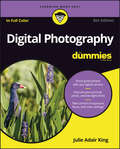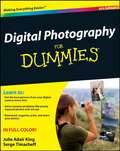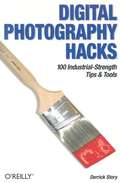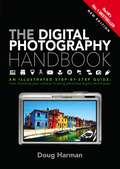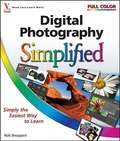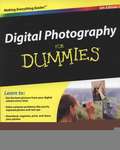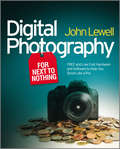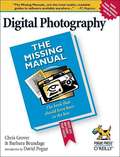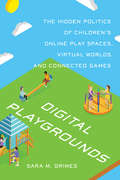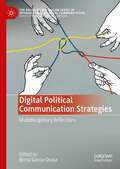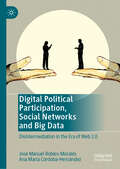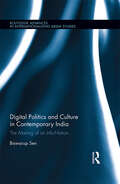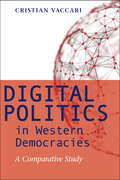- Table View
- List View
Digital Photography FAQs
by Jeff WignallStraightforward, clear answers to the most commonly asked digital photography questionsWhat's the difference between optical zoom and digital zoom? Do more megapixels equate to better photo quality? Why is there a delay after I push the shutter release button before I can take another picture? If you?ve ever asked a question concerning digital photography and wished you had a helpful resource to provide you with clear, reliable answers, then look no further.With nearly four decades of photo experience under his belt, author Jeff Wignall responds to 365 of the most common digital photography questions with informative, practical replies. The full-color format helps you see what he's talking about.Boasts a colorful yet simple design that helps you find exactly the information you?re looking for Illustrates each answer with one or more photos Eliminates any ambiguity by providing you with authoritative answers along with clear illustrationsDigital Photography FAQz is a well-organized guide, featuring answers to questions that you haven?t even thought of yet!
Digital Photography For Dummies
by Julie Adair KingA new edition gets you in the picture for learning digital photographyWhether you have a point-and-shoot or digital SLR camera, this new edition of the full-color bestseller is packed with tips, advice, and insight that you won't find in your camera manual. Digital photography guru Julie Adair King presents you with new and extensively updated information on topics that is written for fledgling photographers in a fun and friendly style. You'll explore tips for finding the gear that best suits your needs, using built-in tools, working with focus and exposure, and shooting like a pro.However, if you've already got an archives full of photos, then this guide shows you how to upload, edit, manage, and share your images. Advice for prolonging battery life, an honest look at the pros and cons of digital SLR, and a helpful glossary are all aimed at making your experience with digital photography picture perfect!Shows you how to set up your camera for basic shooting and use automatic mode, common scene modes, and all the camera's featuresExplains how to edit your images and fix common problems like dim lighting or red-eyeHighlights ways to print photos at home or through a service and then posting online to social sites or send to a cell phoneHelps you manage depth of field, exposure, and white balanceDigital Photography For Dummies, 7th Edition provides you with rich, full-color examples throughout to help your digital pictures say more than a thousand words!
Digital Photography For Dummies, 6th Edition
by Julie Adair King Serge TimacheffYour digital camera can do so much! And Digital Photography For Dummies, 6th Edition helps you shoot, edit, and share great photos. This full-color guide is packed with stuff that's not in your camera manual - tips on upgrading your equipment, working with focus and exposure, shooting like a pro, organizing and enhancing your images, and printing them or getting them online. Are you already you're hip-deep in images? Here's how to manage them. This guide helps you learn what you need for the way you take pictures, how to prolong battery life, the pros and cons of digital SLR, and more. Baffled by the lingo? The glossary explains all those terms and acronyms. You'll also learn to: Set up your camera for basic shooting and learn to use automatic mode, common scene modes, and all the camera's features Manage depth of field, exposure, and white balance, and make easy fixes with your photo editor Compose your photos for better pictures Easily transfer your pictures to the computer, print them, or distribute them electronically Edit your images and fix common problems like dim photos and red-eye Send photos to a cell phone Organize your pictures so you can find what you want Decide if your camera needs updating, what equipment you need, and what your digital darkroom should have Rich, full-color examples show what you can achieve. Digital Photography For Dummies, 6th Edition will make your digital camera a lot more fun!
Digital Photography For Dummies: Quick Reference (For Dummies Ser.)
by Julie Adair KingPhotographers! Your guide is here! The demand for high-quality photographs is higher than ever. Whether you’re building your influencer rating online, capturing the moments of a child’s life, or are looking for ways to improve your skills, photography know-how is a must-have skill. Digital Photography For Dummies helps you do more than pointing, shooting, and hoping for the best or slapping a filter on a camera phone shot. This book introduces you to the camera settings and techniques that separate okay pictures from frame-worthy portraits. It then explains how to apply those skills to capturing your own portraits, landscape shots, and high-action photos. Develop a better eye for image composition Discover how to light photos better, including using natural light Learn to get quick results in auto settings or take full control in manual mode Discover the elements of exposure and how they influence the final product Find instructions on taking a formal or casual portrait Apply basic editing techniques to finalize your image Go beyond photo apps and apply the techniques pros use for their images.
Digital Photography For The Over 50s: Teach Yourself
by Peter CopeDo you want to get to grips with your camera? Do you want to take some great photos and make them even better using your computer?Do you want to learn how to create great photo albums, share photos on the internet, even create slideshows to share with family and friends?Teach Yourself Photography for the Over 50s shows you how to choose a digital camera, become familiar with its functions and use it to produce some memorable photos. The book uses clear instructions, useful hints and tips and illustrations to show you all the essential techniques. Avoiding jargon and computerspeak, it also shows you how to use your computer with your camera and explores opportunities for producing great photos without a computer.NOT GOT MUCH TIME?One, five and ten-minute introductions to key principles to get you started.AUTHOR INSIGHTSLots of instant help with common problems and quick tips for success, based on the author's many years of experience.TEST YOURSELFTests in the book and online to keep track of your progress.EXTEND YOUR KNOWLEDGEExtra online articles at www.teachyourself.com to give you a richer understanding of digital photography.FIVE THINGS TO REMEMBERQuick refreshers to help you remember the key facts.TRY THISInnovative exercises illustrate what you've learnt and how to use it.
Digital Photography For The Over 50s: Teach Yourself (Teach Yourself Computing Ser.)
by Peter CopeDo you want to get to grips with your camera? Do you want to take some great photos and make them even better using your computer?Do you want to learn how to create great photo albums, share photos on the internet, even create slideshows to share with family and friends?Teach Yourself Photography for the Over 50s shows you how to choose a digital camera, become familiar with its functions and use it to produce some memorable photos. The book uses clear instructions, useful hints and tips and illustrations to show you all the essential techniques. Avoiding jargon and computerspeak, it also shows you how to use your computer with your camera and explores opportunities for producing great photos without a computer.NOT GOT MUCH TIME?One, five and ten-minute introductions to key principles to get you started.AUTHOR INSIGHTSLots of instant help with common problems and quick tips for success, based on the author's many years of experience.TEST YOURSELFTests in the book and online to keep track of your progress.EXTEND YOUR KNOWLEDGEExtra online articles at www.teachyourself.com to give you a richer understanding of digital photography.FIVE THINGS TO REMEMBERQuick refreshers to help you remember the key facts.TRY THISInnovative exercises illustrate what you've learnt and how to use it.
Digital Photography Hacks
by Derrick StoryGoing beyond the standard fare of most digital photography books, Digital Photography Hacks shares the knowledge that professional photographers have learned through thousands of shots' worth of experience and years of experimentation. With exquisite, full-color photos throughout, the book presents 100 proven techniques in the areas of daytime and nighttime photo secrets, flash magic, digital camera attachments, fun photo projects, camera phone tricks, and more. This book is your passport to taking the kind of digital photos you've always aspired to.
Digital Photography Hacks: 100 Industrial-Strength Tips & Tools
by Derrick StoryYour digital camera is more than a new incarnation of your old film camera. Yes, it still produces photos, but it also offers new outlets for creativity, including instant gratification of seeing your photos now, the ability to experiment without worrying about expense, the technology to fine-tune your photos with advanced professional techniques, and the means to share your work instantaneously with anyone, anyplace in the world. It's no wonder that digital cameras are outselling traditional cameras for the first time ever. But the question most digital camera users ask is this, "How do I get from taking 'decent' photos to doing the things I'd really like to do? How do I tap into that potential?" Digital Photography Hacks is your passport to taking the kind of digital photos you've always aspired to. Written by Derrick Story, photographer and author of Digital Photography Pocket Guide and other books, it goes beyond the standard fare of most digital photography books--such as camera basics, understanding memory cards, and when to use a flash--to the things that professional photographers have learned through thousands of shots' worth of experience, years of experimentation, and fiddling and hacking. The book includes a foreword by photographer Rick Smolan, author of America 24/7. With exquisite, full-color photos throughout, the book presents a collection of tips, tricks, and techniques for photographers ready to move beyond the basics. And if you don't have the latest in digital camera photography, this book will show you how to extend the life and functionality of your existing camera. All the hacks in the book are platform-agnostic, designed for use on both Mac on Windows-based computers. You'll find 100 proven techniques in the areas of: Daytime and nighttime photo secrets Flash magic Digital camera attachments The computer connection Photoshop magic Fun photo projects Camera phone tricks This book is for the photographer you are now, and the one you want to be. Digital Photography Hacks is for the creative adventurer who resides in each of us.
Digital Photography Handbook
by Doug Harman David JonesIn the last few years digital cameras and "digital darkrooms" in the form of computers and image manipulation software have revolutionized modern photography. Truly professional results are tantalizingly within reach of all--and The Digital Photography Handbook shows you how to combine photographic flair with digital expertise to achieve them. Part one looks at the cameras, the lenses and other hardware accessories, explains the technology behind them and helps you choose exactly what you need. Part two explores the art of photography itself, from composing a shot to considerations such as depth of field, focus or exposure. It also examines a series of themes such as landscapes, weddings and holidays providing tips and ideas for how to photograph them. Part three moves into the "digital darkroom". Here, expert instruction will give you the confidence to correct common problems and get the most out of your images, while a series of masterclasses focuses on professional image manipulation techniques and artistic effects, breaking them down into step-by-step stages for you to follow. Finally, part four looks at printing your photographs--whether to paper or on to the web. For those interested in taking their photography a little further, it explores building a portfolio and offers advice on copyright and selling your pictures.In this new, updated edition Doug Harrman includes the very latest developments in digital technology, equipping you with everything you need to become an accomplished 21st-century photographer.
Digital Photography Masterclass: Advanced Photographic Techniques for Creating Perfect Pictures (DK Tom Ang Photography Guides)
by Tom AngFeaturing tutorials, image analyses, assignments, and step-by-step image manipulation exercises, Digital Photography Masterclass explains how to see the world with a photographer's eyes. Stunning images and stylish design make this book a great tool for anyone looking to learn about the technical and creative aspects of photography and post-production.
Digital Photography Pocket Guide, 3rd Edition
by Derrick StoryEven film diehards have a tough time resisting the instant gratification of the digital camera. Today's digital cameras are more affordable then ever before, and they deliver high quality images that are a snap to share. Plus, you can take risks with a digital camera you never would with a film camera. You waste nothing; there's no film required, and because you only print the pictures you need, digital photography is cost effective and environmentally friendly. But to take full advantage of a digital camera, you need to be an experienced photographer and an expert at digital photography too. With more than 15 years of experience as a photojournalist, author Derrick Story brings you Digital Photography Pocket Guide , 3rd Edition. For everyone who owns or will own a digital camera (and that pretty much means everyone!), this is the perfect on-the-go guide for taking top-notch digital photos. In this third edition of the bestselling pocket guide, Story expands on the basic photography techniques that he introduced in earlier editions, including an explanation of each camera component and what it does, tips for choosing just the right settings for your needs, and much more. This indispensable guide covers everything from how to shoot sports action, close ups, and night shots, to dealing with image resolution, archiving, and memory cards. Affordable and portable, Digital Photography Pocket Guide , 3rd Edition offers full-color photographs, screen shots, and line art illustrating all the topics in the guide's three main sections ("Digital Camera Components," "Standard Camera Functions," and "How Do I?"). Contents are labeled A to Z for quick reference. There's also a comprehensive table of contents and index so you'll waste no time flipping to the specific information you need--whether you want to transfer images, make a QuickTime movie, or just figure out what purpose that mystery setting on your camera serves. There's even a section of easy-to-read reference tables for quick look-up of white balance settings, exposure compensation, camera mode explanations, and plenty more.
Digital Photography Pocket Guide: Pocket Guide
by Derrick StoryEven film diehards have a tough time resisting the instant gratification of the digital camera. Today's digital cameras are more affordable then ever before, and they deliver high quality images that are a snap to share. Plus, you can take risks with a digital camera you never would with a film camera. You waste nothing; there's no film required, and because you only print the pictures you need, digital photography is cost effective and environmentally friendly.But to take full advantage of a digital camera, you need to be an experienced photographer and an expert at digital photography too. With more than 15 years of experience as a photojournalist, author Derrick Story brings you Digital Photography Pocket Guide, 3rd Edition. For everyone who owns or will own a digital camera (and that pretty much means everyone!), this is the perfect on-the-go guide for taking top-notch digital photos.In this third edition of the bestselling pocket guide, Story expands on the basic photography techniques that he introduced in earlier editions, including an explanation of each camera component and what it does, tips for choosing just the right settings for your needs, and much more. This indispensable guide covers everything from how to shoot sports action, close ups, and night shots, to dealing with image resolution, archiving, and memory cards.Affordable and portable, Digital Photography Pocket Guide, 3rd Edition offers full-color photographs, screen shots, and line art illustrating all the topics in the guide's three main sections ("Digital Camera Components," "Standard Camera Functions," and "How Do I?"). Contents are labeled A to Z for quick reference. There's also a comprehensive table of contents and index so you'll waste no time flipping to the specific information you need--whether you want to transfer images, make a QuickTime movie, or just figure out what purpose that mystery setting on your camera serves. There's even a section of easy-to-read reference tables for quick look-up of white balance settings, exposure compensation, camera mode explanations, and plenty more.
Digital Photography Simplified, 2nd Edition
by Rob SheppardGo from digital photography set up to print out with this easy-to-understand visual resource Digital photography makes taking pictures easier, but learning the tools to develop and manipulate those pictures can be a bit overwhelming. This full-color guide demystifies the latest digital camera models and their features and inspires you to be more creative with your camera and in your image editing. Packed with completely new photos, this updated edition offers two-page tutorials and step-by-step instructions for taking better pictures, understanding composition and lighting, avoiding over or under exposure, editing and organizing photos, and making simple changes that can result in beautiful photos. Updated coverage addresses the newest video capabilities and guides you through effectively using common digital imaging software. Plus, straightforward instruction and large font and image sizes make this book an ideal resource for both mature audiences and novice photographers. Offers easy-to-understand, practical instruction for setting up your camera--whether it's a compact or digital SLR--and learning its program modes Encourages you to experiment with lenses and focal length, download and organize your images, and fine-tune your photos with Photoshop Elements Explains good composition and exposure, tools and equipment choices, basic exposure, flash settings, and more Features full-color screen shots that demonstrate each task and stunning photos that inspire This easy-to-understand book provides you with invaluable advice and simplifies the world of digital photography so you can get the best shot possible, simply.
Digital Photography Through the Year (DK Tom Ang Photography Guides)
by Tom AngSpring, summer, fall, and winter — discover a unique and practical guide to capturing breathtaking photos of each season.From photographing a dewdrop in spring to a beautiful winter frost, follow your hobby throughout the year with renowned photographer Tom Ang.This digital photography guide will teach you how to capture each season, month by month. Discover: • The latest camera kit and photography equipment. • Tips and tricks for creating striking images inspired by the seasons. • Feature spreads that explain key techniques in a practical and applied way, while illustrated tips suggest alternative approaches. • A "back to basics" ethos encourages the use of simple equipment to get desired shots — many photos in the book were made with phone cameras. Digital Photography Through the Year is an inspiring and practical guide to taking beautiful photos, whatever the season and weather conditions. Author, Tom Ang, explores inventive photography techniques, giving advice and project ideas to inspire you throughout the year. This fully updated third edition includes the latest developments in technology, equipment and current trends. Learn all you need to know to take great photographs that convey a sense of time, place and atmosphere. Perfect for beginners and experts alike, you&’ll find helpful techniques to help you get the most out of your shots using different photography equipment — from the best digital SLRs down to camera phones.
Digital Photography for Dummies
by Julie Adair King Serge TimacheffA number of things have changed in the digital photography world since the last edition published: Consumer priced point-and-shoot cameras with 10+ megapixels have hit the market. Digital SLR cameras have fallen in price to the point that first-time photographers are buying them as their first cameras. New versions of the popular Photoshop Elements editing software have been released. Windows Vista came out with new photo organization tools. New accessories like digital photo frames have become hot commodities. New photo hosting communities have popped up. This update addresses all those changes alongside the classic help for selecting a camera, shooting quality photos, managing files from a camera onto a computer, editing out the bad parts, and sharing via print, online, or other means.
Digital Photography for Next to Nothing
by John LewellTake photos like a pro without breaking the bank by using FREE and nearly FREE software and hardware explained in this book.Get professional looking shots from a low-cost cameraSave money by building your own lighting rigs, tripods, monopods and stabilisers for next to nothingLearn how to use older lenses on modern digital cameras, and make your own macro lens, lens hoods, flash diffusers, flash concentrators, decorative Bokeh effect lenses and moreUse dozens of FREE and low cost photo applications for processing, viewing, cataloguing, editing, creating HDR, and photo stitchingBuild powerful photography processing and editing suites with free software and plugins that go head to head with expensive tools like Adobe Photoshop and Lightroom
Digital Photography for the Older and Wiser
by Kim GilmourHelpful, easy-to-follow guide for new digital photographers over the age of 50Digital photography is a fun and exciting hobby, but digital cameras can be overwhelming and daunting to a newcomer. If you're entering the digital photography world as an older adult--and wondering about which digital camera will meet your needs--this straightforward, helpful book is for you.Written in full colour with lots of screenshots and clear, easy-to-read type, this friendly guide assumes no previous experience in digital photography and walks you through the subject of digital photography from start to finish: selecting which type of digital camera is right for you, understanding the seemingly endless jargon, benefiting from valuable photograph tips, and much more.Provides guidance for purchasing your digital camera and deciphers the common jargon that is used in the fieldWalks you through all the features and functions of a digital cameraReveals top photography tipsExplains how to retouch, enhance, and print your photosDemonstrates easy ways to share photos with friends and familyPrepare properly, enjoy the freedom, and maybe even show the family a thing or two with this fun and practical guide!
Digital Photography: Expert Secrets for Shooting More Professional Images (Idiot's Guides)
by Shawn FrederickIdiot's Guides®: Digital Photography is the simplest guide to becoming a better photographer and taking better pictures with any basic digital camera or DSLR. Instead of focusing on complicated and quickly outdated topics like gear or retouching software, you'll learn the timeless principles of good photography, the essentials of every camera and lens, and how to use all that knowledge to take the pictures you previously thought were only achievable by professional photographers. You'll learn how to set up every shot, avoid common mistakes, and do more with your pictures through unique and creative digital photography projects. Focused on making people better photographers, this easy-to-understand, full-color guide finally simplifies the process of taking great pictures by focusing on what people really need to know.
Digital Photography: Expert Techniques
by Ken MilburnThis absorbing book, by professional photographer and author Ken Milburn, offers a ton of expert advice to those who are ready to move to the next level with digital photography. Rather than a general discussion of photography principles, Digital Photography: Expert Techniques focuses on workflow: time-tested, step-by-step procedures based on hard-nosed experience by and for genuine practitioners of the art. The book's conversational tone presents detailed information about what to look for in today's affordable high-end digicams, how to use simple techniques and equipment to shoot breathtaking shots, instructions on shooting great panoramas, dos-and-don'ts for creating better Photoshop masks, and professional digital darkroom techniques for everything from knockouts to restoration to transforming your photos into watercolors. It even shows you how to get your most prized photographs printed and ready for exhibition. Contents include: Understanding your digital camera from the inside out. Creating effects with the camera: making panoramas, high-resolution matrixes, infrared photos, and more. General composition and managing your workflow. Using the digital darkroom and Photoshop CS to make your images professional caliber. Understanding the power of Photoshop CS selections and masks. Using special effects to save what's good, and get rid of the bad and the ugly. Creating fictitious photos: bend and wrap images to fit an object, insert a more interesting skyscrape, and more. Professional color and tonal management Creating portfolios and presenting your images on the Web. Digital Photography: Expert Techniques is in four-color front to back, allowing you to see each step in the Digital Photographer's workflow, including the steps in-between. Serious photographers, including professionals, who want to take advantage of the unique creative powers available through digital photography and digital image processing will find this problem-solving book invaluable.
Digital Photography: The Missing Manual
by Barbara Brundage Chris GroverDigital Photography: The Missing Manual helps you to take beautiful digital pictures -- of your baby, your trip to Paris, your new pet iguana--and then share the stunning results with your friends and family. Spiked with the advice and humor that are trademarks of the Missing Manual series, this book shows you how to: Master your digital camera. Learn how to use those mysterious buttons and modes to improve your pictures. Take memorable photos. Become a better photographer right away with a few simple tricks from the pros. Edit your photos to remove red eye, or crop out extraneous buildings. Add colors and effects not normally found in nature. Share your pictures using the best programs and Web sites for sharing your photos-in print, online, and via ESP. This is a great book for people who want to get started with digital photography but it's also perfect for those who need to increase the skills they already have. Intermediate digital photographers will love the tips and tricks from the pros and the helpful buying guides for those accessories they're ready to add. Note: This book is Windows-only. For Mac fans, iPhoto 6: The Missing Manual has a whole section on digital photography.
Digital Playgrounds: The Hidden Politics of Children’s Online Play Spaces, Virtual Worlds, and Connected Games
by Sara GrimesDigital Playgrounds explores the key developments, trends, debates, and controversies that have shaped children’s commercial digital play spaces over the past two decades. It argues that children’s online playgrounds, virtual worlds, and connected games are much more than mere sources of fun and diversion – they serve as the sites of complex negotiations of power between children, parents, developers, politicians, and other actors with a stake in determining what, how, and where children’s play unfolds. Through an innovative, transdisciplinary framework combining science and technology studies, critical communication studies, and children’s cultural studies, Digital Playgrounds focuses on the contents and contexts of actual technological artefacts as a necessary entry point for understanding the meanings and politics of children’s digital play. The discussion draws on several research studies on a wide range of digital playgrounds designed and marketed to children aged six to twelve years, revealing how various problematic tendencies prevent most digital play spaces from effectively supporting children’s culture, rights, and – ironically – play. Digital Playgrounds lays the groundwork for a critical reconsideration of how existing approaches might be used in the development of new regulation, as well as best practices for the industries involved in making children’s digital play spaces. In so doing, it argues that children’s online play spaces be reimagined as a crucial new form of public sphere in which children’s rights and digital citizenship must be prioritized.
Digital Political Communication Strategies: Multidisciplinary Reflections (The Palgrave Macmillan Series in International Political Communication)
by Berta García-OrosaThis book, with a foreword by Manuel Castells, explores the core strategies of digital political communication. It reviews the field’s evolution over the past 25 years and examines the coexistence of old and new actors (lobbyists, citizens, parliaments, political parties, media outlets, digital platforms, among others), as well as hybrid communication tactics. Topics covered include frames, fake news, filter bubbles, echo chambers, artificial intelligence, the significance of emotions, and engagement with citizens.As we find ourselves in the fourth wave of digital communication, and in the wake of a pandemic which has shaken the foundations of political communication, an evaluation of these topics is essential to the reinvention of democracy. The book is geared towards students and researchers who wish to delve into the latest trends in digital communication, political communication actors and journalists. It further aims to prepare citizens to effectively deal with messaging that blurs the line between truth and falsehood with increasingly powerful strategies supported by artificial intelligence.
Digital Political Participation, Social Networks and Big Data: Disintermediation in the Era of Web 2.0
by José Manuel Robles-Morales Ana María Córdoba-HernándezThis book explores the changes in political communication in light of the development of a public opinion mediated by web 2.0 technologies. One of the most important changes in political communication is related to the process of disintermediation, i.e. the process by which digital technologies allow citizens to compete in the public space with those agents who, traditionally, co-opted public opinion. However, while disintermediation has undeniably generated a number of advances, having linked citizens to the public debate, the authors highlight some aspects where disintermediation is moving away from a rational and inclusive public space. They argue that these aspects, related to the immediacy, polarization and incivility of the communication, obscure the possibilities for democratization of digital political communication.
Digital Politics and Culture in Contemporary India: The Making of an Info-Nation (Routledge Advances in Internationalizing Media Studies)
by Biswarup SenThe relationship between information and the nation-state is typically portrayed as a face-off involving repressive state power and democratic flows: Twitter and the Arab Spring, Google in China, WikiLeaks and the U.S. State Department. Less attention has been paid to those scenarios where states have regarded information and its diffusion as productive of modernity and globalization. It is the central argument of this book that the contemporary nation-state, especially in the global South, is far from hostile to the current informational milieu and in fact makes crucial use of it in order to develop adequate modes of governance, communication and sociality in a networked world. This book focuses on India – an emerging country that has recently witnessed a "software miracle" – to highlight the critical role informatics has historically played in the national imagination and to demonstrate how the state, private capital and civic society have drawn upon and engaged the precepts and protocols of the information age to fashion an "info-nation."
Digital Politics in Western Democracies: A Comparative Study
by Cristian VaccariA comparative analysis of political websites and their users from seven Western democracies.Digital politics is shorthand for how internet technologies have fueled the complex interactions between political actors and their constituents. Cristian Vaccari analyzes the presentation and consumption of online politics in seven advanced Western democracies—Australia, France, Germany, Italy, Spain, the United Kingdom, and the United States—from 2006 to 2010. His study not only refutes claims that the web creates homogenized American-style politics and political interaction but also empirically reveals how a nation’s unique constraints and opportunities create digital responses. Digital Politics in Western Democracies is the first large-scale comparative treatment of both the supply and the demand sides of digital politics among different countries and national political actors. It is divided into four parts: theoretical challenges and research methodology; how parties and candidates structure their websites (supply); how citizens use the websites to access campaign information (demand); and how the research results tie back to inequalities, engagement, and competition in digital politics. Because a key aspect of any political system is how its actors and citizens communicate, this book will be invaluable for scholars, students, and practitioners interested in political communication, party competition, party organization, and the study of the contemporary media landscape writ large.

